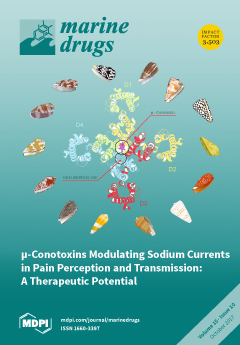Hepatocellular carcinoma (HCC), also named cancerous hepatoma, is the most common type of malignant neoplasia of the liver. In this research, we screened the Persian Gulf sea cucumber
Holothuria parva (
H. parva) methanolic sub-fractions for the possible existence of selective toxicity
[...] Read more.
Hepatocellular carcinoma (HCC), also named cancerous hepatoma, is the most common type of malignant neoplasia of the liver. In this research, we screened the Persian Gulf sea cucumber
Holothuria parva (
H. parva) methanolic sub-fractions for the possible existence of selective toxicity on liver mitochondria isolated from an animal model of HCC. Next, we purified the most active fraction. Thus the structure of the active molecule was identified. HCC was induced by diethylnitrosamine (DEN) and 2-acetylaminofluorene (2-AAF) protocol. Rat liver mitochondria for evaluation of the selective cytotoxic effects of sub-fractions of
H. parva were isolated and then mitochondrial parameters were determined. Our results showed that C1 sub-fraction of methanolic extract of
H. parva considerably increased reactive oxygen species (ROS) generation, collapse of mitochondrial membrane potential (MMP), swelling in mitochondria and cytochrome c release only on HCC liver mitochondria. Furthermore, the methanolic extract of
H. parva was investigated furthermore and the active fraction was extracted. In this fraction, (
Z)-2,3-diphenylacrylonitrile molecule, which is also known as α-cyanostilbene, was identified by mass analysis. This molecule increased ROS generation, collapse of MMP, swelling in mitochondria and finally cytochrome c release only on HCC liver mitochondria. The derivatives of (
Z)-2,3-diphenylacrylonitrile in other natural products were also reported as an anti-cancer agent. These results suggest the eligibility of the (
Z)-2,3-diphenylacrylonitrile as a complementary therapeutic agent for patients with HCC.
Full article






